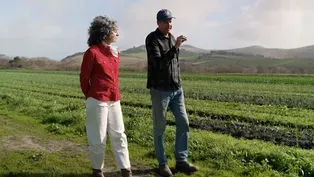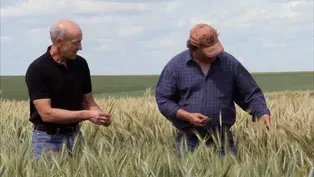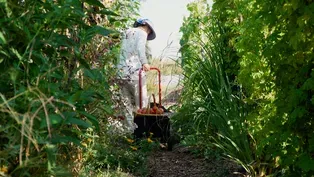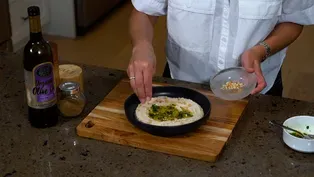
Blue House Farms
Clip: 8/16/2024 | 4m 24sVideo has Closed Captions
A farmer builds housing for his workers right on the land.
Meet a farmer growing diverse vegetables by California's pacific coast. It's an expensive place to live. That motivated him to build farmworker housing, right on the land.
America's Heartland is presented by your local public television station.
Funding for America’s Heartland is provided by US Soy, Sustainable Agriculture Research and Education, Rural Development Partners, and a Specialty Crop Grant from the California Department of Food and Agriculture.

Blue House Farms
Clip: 8/16/2024 | 4m 24sVideo has Closed Captions
Meet a farmer growing diverse vegetables by California's pacific coast. It's an expensive place to live. That motivated him to build farmworker housing, right on the land.
How to Watch America's Heartland
America's Heartland is available to stream on pbs.org and the free PBS App, available on iPhone, Apple TV, Android TV, Android smartphones, Amazon Fire TV, Amazon Fire Tablet, Roku, Samsung Smart TV, and Vizio.
Providing Support for PBS.org
Learn Moreabout PBS online sponsorship♪♪♪♪♪ Ryan: I don't know that when I started here, I thought I would never own a piece of property out here on the coast.
Narr: Transformation seems to be a common theme in Ryan Casey's life.
He didn't come from a farm family.
When he started college.
He was actually thinking about a career in environmental sciences.
But then Ryan took a couple of ag classes and after college, worked on a few farms and gardens.
That's when his life path was transformed, and his passion for working the land fully realized.
Ryan: My best advice is to go work for somebody, who's really good at what they do.
Go find a farmer and work for that person and... and learn as much as you can from somebody who's... who's been through the good, bad and the ugly and know what you're getting yourself into.
Narr: In 2016, what Ryan ended up getting into was a chance to lease some 80 acres of rich farmland near the northern California coastal town of San Gregorio.
An astonishing variety of organic crops are grown here, from potatoes to cabbage, onions, tomatoes, carrots, peppers, herbs and much more.
It's sold at nearby farmers markets, but visitors can also shop each weekend right here at the new Barn and Farm Stand, built by Ryan and his friends.
All that's part of what you might call a second transformation for Ryan.
This was a multi-generational family farm that, frankly, had seen better days.
It may have looked all right at first glance and perhaps from a distance.
Ryan: And then we start looking close up, you realize there's actually quite a quite a lot of work that needs to go into getting the infrastructure where it needs to be, to support a farm again.
Narr: Restoring this farm's infrastructure took years of hard work, but today there's a vastly improved irrigation system.
The farm draws water from a nearby riparian creek during the wetter winter months, and only uses water from the newly restored pond during the summer that protects the creek's ecosystem.
The farm also has a new packing shed, new greenhouses where herbs are grown and harvested, and perhaps most important, new farm worker housing, including four three bedroom mobile home units, a domestic well and a new septic system.
In a region where housing is both scarce and expensive.
Yolanda Guzman says these lower rent units have been a life saver for her fellow farm employees.
[Yolanda speaks spanish] - I just hope that it keeps growing and growing and hopefully we can have more housing for more workers.
It's very important because consumers can enjoy all the products, all the vegetables.
There's food on the table every day.
Ryan: I was struggling greatly with finding, secure, stable labor.
And having housing on site has allowed me to... to really stabilize that, to attract really great people.
Narr: Ryan is quick to credit others for his farm success, especially an organization called POST.
The Peninsula Open Space Trust, a nonprofit dedicated to preserving and restoring open space, forests, parks and farmland in this part of Northern California.
They bought this farm and leased it to Ryan, and early in 2024 sold it to him outright.
Ryan: I'm extremely thankful for POST.
I, uh, don't think that I would be farming out here on this coast if it wasn't for their support.
Daniel: Farms should be owned by farmers, we believe that.
It's incredible to be able to see, uh, a farmer who started on our property be able to take on ownership of this farm and know that it's going to be in good hands for generations to come.
Narr: There are major efforts underway across America to find, train and encourage the next generation of farmers.
Experts agree programs that preserve farmland and help farmers like this one and many others, will ensure that most of our nation's future food needs will be met right here at home.
Ryan: It just feels great.
It feels great to be stable and to know that I'm not going anywhere and I can invest in where I'm at.
Diversified Farms – Harvesting Health
Video has Closed Captions
Our health expert explains why farms that grow a diverse range of crops may be better for our health (4m 39s)
Video has Closed Captions
Meet farmers growing wheat in a very dry climate. (4m 35s)
Growing Opportunities for Refugees
Video has Closed Captions
Visit a farm run by the International Rescue Committee that provides refugees a place to grow. (5m 33s)
White Bean Dip – Farm to Fork with Sharon Profis
Video has Closed Captions
Discover how to make a white bean dip appetizer. (4m 1s)
Providing Support for PBS.org
Learn Moreabout PBS online sponsorshipAmerica's Heartland is presented by your local public television station.
Funding for America’s Heartland is provided by US Soy, Sustainable Agriculture Research and Education, Rural Development Partners, and a Specialty Crop Grant from the California Department of Food and Agriculture.















